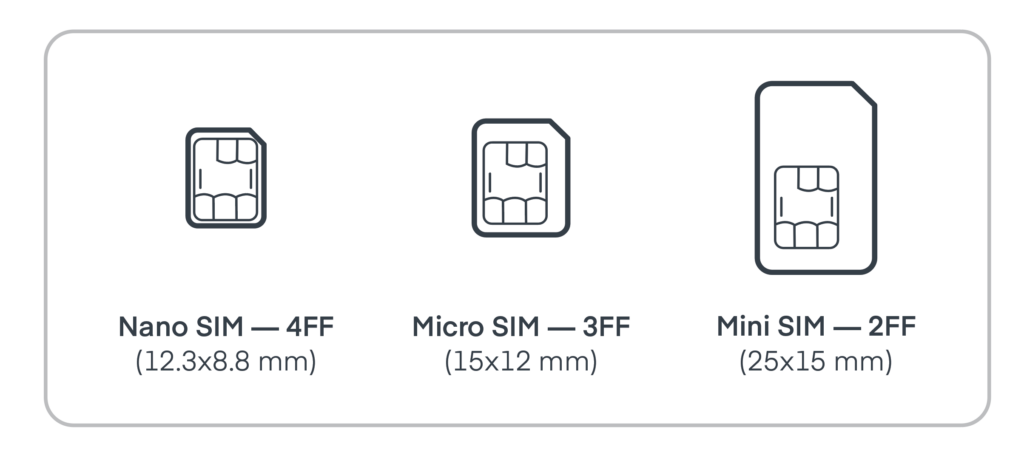Table of Contents
A SIM card is one of the crucial elements in mobile devices. It is a conventional microchip, which is arranged in such a way that the entire assembly fits into miniature dimensions. And, each new generation of sims has smaller chip sizes.
Modern SIM cards are needed for any device to access the operator’s network, from modems installed in trucks to standard cellular phones. It provides your gadget with cellular communication and the ability to access the Internet. A SIM card is a mini-computer with a processor, small memory, and an encryption system.
Read about what SIM cards are, their types and differences, how much does a SIM card cost in different parts of the world, and why eSIMs are the best option in this article.
Related: “Do I Need to Convert My SIM to eSIM?“
SIM cards Types & Their Differences
What is a sim card in general? This is an electronic module for user identification. One can change mobile devices while keeping a single number of a particular sim. Plastic cards are simply rearranged from the previous smartphone to the new one.
During the entire existence of the given module, it has changed its size several times. Like many electronic devices, such as a computer, sim cards constantly shrank in format. However, regardless of the size, the SIM card has retained its functionality.

So, at the moment, there are five types of SIM card, depending on the size:
- full-format
- mini sims
- micro-size chips
- nano
- an eSIM
General SIM-card typology
- Full-format card. Undoubtedly, full-size modules for mobile phones are a relic of the past. Such sims were used in the first cellular phones and had impressive dimensions — 86 x 54 x 0.84 mm. It was the size of a bank card. Today, a full-size mobile sim is not used and can only be seen in museums.
- Mini SIM. This SIM card format has replaced full-size ones, but it is also considered obsolete today. However, the mini-SIM is still used in older models of push-button gadgets. The dimensions of such a cellular module are 25 x 15 x 0.76 mm.
- Micro-size chip. This type has been used since the mid-2000s. The module is already significantly smaller than the previous format (15 x 12 x 0.76 mm) and takes up less device room. In recent years, it has been used less and less, as it has been replaced by an even more compact SIM card — nano-SIM card.
- Nano format. Nowadays, this is one of the most popular types of mobile sims. Its ordinary size is only 12.30 x 8.80 x 0.67 mm. It consists of a single chip without plastic edges. This type of SIM card was introduced by Apple in 2012.
- eSIM. This name refers to the built-in SIM card (an embedded module, that is, e-SIM). This is a digital chip soldered into a smartphone, tablet, or wearable device at the manufacturing stage.
The mobile operator will provide the subscriber not with an ordinary physical “SIM card” but encrypted data. This solution allows you to remove SIM card slots from devices, freeing up space and using multiple mobile operator profiles in one device.
How Much Does a SIM card Cost in Countries Worldwide?
Are you interested in the cost of SIM cards in different countries? If yes, read on to learn about SIM cards and how much you can spend on them in popular places worldwide.
USA
The cost of a SIM card in the USA depends on which mobile operator you choose. Mainly, one can purchase a sim card for just $1, but getting a prepaid data plan with this sim card will be much more expensive.
On average, users can purchase data-only SIM cards for $15-20 or SIMs that include free minutes and SMS in the same price range but with less data transfer costs.

The United Kingdom
Regular mobile sims in the United Kingdom have a price starting from £1, but you won’t be able to do anything with them until you spend a lot of money on them. Once you transfer more money to this cellular module, you can spend it on mobile calls and text messages or purchase a prepaid package if the carrier provides it.

South American Countries
The price of sims in South America depends on a particular region. Mobile SIMs in most South American places are affordable, usually cheaper than in Europe, the USA, and even Australia. The exact cost may vary, but in most South American countries, one can purchase one of the most profitable prepaid cellular tariff plans for only 5-10 dollars.

The Baltic states
Here, expect to spend from $1 to $10.65 for the cheapest SIM card in Estonia. The SIM card prices will be slightly higher in Latvia and Lithuania — from $1.15 to $26.70. But this is in theory. In practice, users spend more on a mobile SIM card in the Baltic countries – at least $3-5.

The eSIM is a Great Alternative to the Physical SIM card
An eSIM is a digital module that allows you to connect to any telecom carrier without a physical SIM chip. It is a fantastic alternative to a common plastic card that connects your device to a mobile network, but the eSIM is much smaller. This is convenient because your phone can have multiple electronic cards without changing or inserting a physical SIM card.

Key differences between a physical SIM card and an eSIM:
- Installation way. The physical sim modules are installed in a cellular device, and the electronic one is already built in.
- Dynamic operator replacement. If there is an eSIM, the user can change operators easily by himself (through the smartphone settings).
- Application. A physical slot is required to install a SIM card, which limits the possibility of putting it on some gadgets. An eSIM can be integrated into various devices, like wireless routers, onboard car systems, GPS navigation etc.
Recently, eSIM services have become more popular among voyagers than a regular plastic sim, but why?
Benefits of using an eSIM card
Like traditional types of SIM card for mobile phones, eSIM lets you connect to a new mobile network abroad and download data packets. Depending on the country you visit, getting a physical SIM card may take a long time. And an eSIM can be programmed using your usual mobile network credentials. Thus, it eliminates the need for a time-consuming registration process.
Moreover, the eSIM can be configured remotely, meaning you can get it (and buy a data package) before going on a trip. This is another less annoying part of the admin job when you go on a trip!
In addition, users buy ESIM packages at a reasonable price, especially compared to roaming fees. Leading providers, such as Airalo, also offer international data plans cheaper than traditional automatic roaming. This makes the virtual SIM card alternative almost ideal for regular voyagers who need to stay connected on the road, and it can also help you not to spend a lot of cash in the long run.





